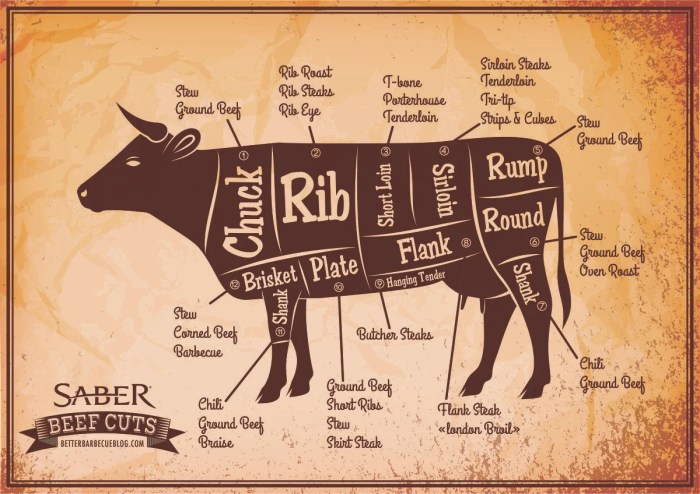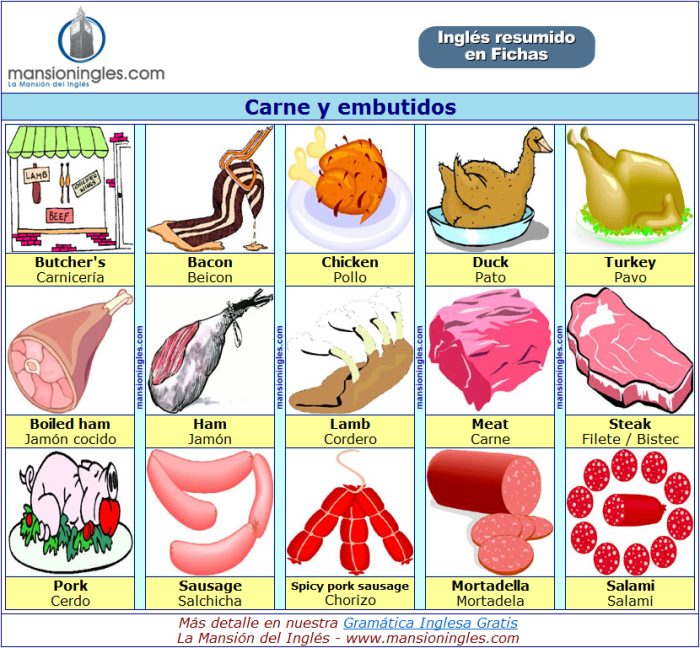Step into the delectable world of nome de carnes em ingles, where we explore the diverse and tantalizing world of meats. From the tender cuts of beef to the succulent flavors of pork, each type of meat holds its own unique charm and culinary significance.
Join us on this gastronomic journey as we delve into the intricacies of meat, its various cuts, cooking methods, and cultural impact.
Our exploration begins with a comprehensive overview of beef, pork, and chicken, examining their distinct flavors, textures, and culinary applications. We’ll then venture into the realm of fish, lamb, and seafood, uncovering the vast array of options available and their nutritional benefits.
Finally, we’ll conclude our adventure with a look at cured meats and the growing popularity of vegetarian and vegan meat alternatives.
Beef

Beef is the meat of cattle, and it is a popular food item around the world. Beef is a good source of protein, iron, and other nutrients, and it can be cooked in a variety of ways. Some of the most popular cuts of beef include:
- Ribeye: The ribeye is a tender and flavorful cut of beef that is taken from the rib section. It is often grilled or roasted.
- Strip steak: The strip steak is a lean and flavorful cut of beef that is taken from the short loin section. It is often grilled or roasted.
- Tenderloin: The tenderloin is the most tender cut of beef, and it is taken from the loin section. It is often grilled, roasted, or pan-fried.
- Ground beef: Ground beef is made from chopped beef, and it is often used in hamburgers, meatballs, and other dishes.
The tenderness, flavor, and cooking methods of different cuts of beef vary depending on the location of the cut on the animal. The following table compares the various types of beef:
| Cut | Tenderness | Flavor | Cooking methods |
|---|---|---|---|
| Ribeye | Tender | Flavorful | Grilling, roasting |
| Strip steak | Lean | Flavorful | Grilling, roasting |
| Tenderloin | Very tender | Mild | Grilling, roasting, pan-frying |
| Ground beef | Ground | Mild | Hamburgers, meatballs |
Beef is a versatile meat that can be used in a variety of dishes. Some of the most popular beef dishes from different cuisines include:
- Steak: Steak is a grilled or roasted cut of beef that is often served with a sauce or gravy.
- Hamburger: A hamburger is a ground beef patty that is cooked and served on a bun with various toppings.
- Meatloaf: Meatloaf is a ground beef dish that is mixed with breadcrumbs, eggs, and spices and then baked.
- Beef stew: Beef stew is a slow-cooked dish that is made with beef, vegetables, and broth.
Pork: Nome De Carnes Em Ingles

Pork, the meat of domestic pigs, is a widely consumed meat worldwide, valued for its versatility, flavor, and nutritional content. It boasts a range of cuts, each with unique characteristics and culinary applications.
Pork Cuts
- Pork Loin:Lean and tender, ideal for roasting, grilling, or stir-frying.
- Pork Belly:Fatty and flavorful, perfect for braising, roasting, or making bacon.
- Pork Shoulder:Tougher but flavorful, suitable for slow-cooking methods like pulled pork or stews.
- Pork Ribs:Meaty and juicy, popular for grilling, barbecuing, or braising.
- Pork Chops:Thinly sliced cuts from the loin or shoulder, great for pan-frying, grilling, or baking.
Cultural Significance
Pork holds cultural significance in various cuisines:
- China:Pork is a staple ingredient, used in dishes like Peking duck, char siu, and dumplings.
- Germany:Pork is prevalent in traditional dishes such as sauerbraten, schnitzel, and bratwurst.
- Spain:Jamón, a cured ham, is a renowned delicacy and a key component in tapas and other dishes.
Pork’s versatility and cultural importance make it a beloved meat, enjoyed by people around the globe.
Chicken
Chicken is one of the most versatile and widely consumed meats in the world. With its mild flavor and tender texture, it is a favorite among people of all ages. There are many different breeds of chicken, each with its own unique flavor and texture.
The most common breed of chicken is the White Leghorn, which is known for its high egg production. Other popular breeds include the Cornish Cross, which is known for its large size and meaty flavor, and the Plymouth Rock, which is known for its hardiness and adaptability.
Parts of a Chicken
A chicken is divided into several different parts, each with its own ideal cooking method. The following table Artikels the different parts of a chicken and their ideal cooking methods:| Part | Ideal Cooking Method ||—|—|| Breast | Roasting, grilling, pan-frying, or baking || Thigh | Roasting, grilling, braising, or stewing || Leg | Roasting, grilling, braising, or stewing || Wing | Roasting, grilling, frying, or baking || Back | Roasting, grilling, or braising || Neck | Making stock or soup || Gizzard | Braising or stewing || Liver | Sautéing or frying || Heart | Sautéing or frying |
Preparation and Consumption
Chicken can be prepared in a variety of ways, including roasting, grilling, frying, baking, and stewing. It can also be used in a variety of dishes, including soups, stews, casseroles, and salads.
Chicken is a popular meat all over the world. In the United States, it is the most popular meat, followed by beef and pork. In China, chicken is also the most popular meat, followed by pork and beef. In India, chicken is the third most popular meat, after beef and pork.
Fish

Fish, an aquatic vertebrate animal, is a valuable food source worldwide. Fish species vary greatly in size, habitat, flavor, and nutritional value. This diversity makes fish a versatile culinary ingredient, enjoyed in various cuisines.Fish can be classified into two main groups: saltwater fish and freshwater fish.
Saltwater fish, also known as marine fish, inhabit the oceans and seas. Examples of saltwater fish include tuna, salmon, cod, and mackerel. Freshwater fish, on the other hand, live in lakes, rivers, and streams. Examples of freshwater fish include trout, bass, catfish, and carp.The
flavor of fish varies depending on the species, diet, and habitat. Some fish, like salmon, have a rich, oily flavor, while others, like cod, have a milder, more delicate flavor. The nutritional value of fish is also variable, but in general, fish is a good source of protein, omega-3 fatty acids, and vitamins and minerals.Fish
can be caught using various methods, including angling, netting, and spearfishing. Once caught, fish can be prepared in a variety of ways, including grilling, frying, baking, and steaming.Fish is an important cultural and economic resource in many regions. In some cultures, fish is considered a symbol of prosperity and good luck.
In other cultures, fish is a staple food source, providing essential nutrients for the population. The fishing industry is also a significant economic driver in many coastal communities, providing employment and income.
Lamb

Lamb is the meat of young sheep, prized for its delicate flavor and tender texture. Its versatility in cooking makes it a culinary favorite, suitable for grilling, roasting, braising, and stewing.
Lamb Cuts
Lamb cuts vary in tenderness and flavor, depending on their location on the animal. Some notable cuts include:
- Leg of lamb:A large, tender cut perfect for roasting or grilling, known for its juicy and flavorful meat.
- Lamb chops:Cut from the rib or loin, these chops are lean and flavorful, ideal for grilling or pan-frying.
- Shoulder of lamb:A versatile cut with a rich flavor, suitable for slow-cooking methods like braising or stewing.
- Rack of lamb:A series of rib chops connected by a central bone, offering a visually appealing and tender presentation.
Lamb Dishes
Lamb has a rich culinary history, with traditional and modern dishes found in various cultures:
- Roasted leg of lamb with mint sauce:A classic British dish featuring a roasted leg of lamb served with a refreshing mint sauce.
- Lamb vindaloo:An Indian curry dish with a spicy and tangy flavor, featuring lamb cooked in a flavorful sauce.
- Lamb tagine:A North African stew with tender lamb cooked in a blend of spices and vegetables.
- Lamb chops with rosemary and garlic:A simple yet flavorful dish featuring grilled lamb chops seasoned with aromatic rosemary and garlic.
Seafood

Seafood encompasses a diverse range of aquatic species, offering a culinary adventure with a wide array of flavors and textures. From the delicate sweetness of shellfish to the robust flavor of crustaceans and the umami-rich depths of mollusks, seafood caters to a variety of palates.
Nutritional Value and Culinary Applications
Seafood is a nutritional powerhouse, boasting high-quality protein, essential fatty acids, and an abundance of vitamins and minerals. Different types of seafood vary in their nutritional composition, but all provide significant health benefits. The table below compares the nutritional value and culinary applications of common seafood types:| Seafood Type | Protein (g/100g) | Omega-3 Fatty Acids (g/100g) | Culinary Applications ||—|—|—|—|| Salmon | 20 | 2.3 | Grilling, baking, sushi, sashimi || Tuna | 25 | 1.5 | Searing, canning, salads || Shrimp | 24 | 0.3 | Stir-frying, grilling, salads || Oysters | 10 | 0.5 | Raw, steamed, fried || Mussels | 20 | 1.2 | Steaming, sautéing, soups |
Learning the names of meats in English can be a helpful way to expand your vocabulary and improve your communication skills. However, it’s important to keep in mind the limitations of your knowledge. For a more comprehensive review of English grammar and vocabulary, check out the mid unit 1 review limits . With this resource, you can brush up on the basics and enhance your language skills even further.
As you continue to learn and practice, you’ll become more confident in using the correct names of meats in English and communicating effectively in a variety of situations.
Sustainable Seafood Practices
As the demand for seafood continues to grow, it is crucial to prioritize sustainable practices to ensure the long-term health of marine ecosystems. Overfishing, habitat destruction, and pollution pose significant threats to marine life. By choosing seafood from sustainable sources, consumers can play a role in protecting the oceans and their inhabitants.
- Look for eco-labels such as the Marine Stewardship Council (MSC) or the Aquaculture Stewardship Council (ASC) to ensure seafood is sourced from well-managed fisheries or aquaculture operations.
- Choose less popular seafood species to reduce pressure on overfished stocks.
- Support local fishermen and seafood markets to minimize transportation emissions.
By embracing sustainable seafood practices, we can continue to enjoy the culinary delights of the sea while preserving marine biodiversity for future generations.
Cured Meats
Cured meats are a diverse group of meat products that have been preserved using various methods, such as salting, smoking, and drying. These techniques not only enhance the flavor and texture of the meat but also extend its shelf life.
Curing Methods
The most common curing methods include:
- Dry Curing:Meat is rubbed with a mixture of salt, spices, and herbs and left to cure in a cool, dry environment.
- Wet Curing:Meat is submerged in a brine solution containing salt, sugar, and other flavorings.
- Smoking:Meat is exposed to smoke from burning wood chips, which infuses it with a distinctive flavor and aroma.
Types of Cured Meats
There are numerous types of cured meats, including:
- Bacon:Dry-cured pork belly that is typically smoked.
- Ham:Dry- or wet-cured pork leg that is often smoked or roasted.
- Sausage:Ground meat that is seasoned, cured, and stuffed into casings.
- Prosciutto:Dry-cured Italian ham that is thinly sliced and often served as an appetizer.
- Salami:Dry-cured sausage made from pork, beef, or a combination of both.
Cured Meat Dishes
Cured meats are used in a wide variety of dishes around the world, including:
- Breakfast:Bacon, ham, and sausage are popular breakfast meats.
- Sandwiches:Cured meats are often used as fillings in sandwiches, such as the classic BLT (bacon, lettuce, and tomato).
- Salads:Cured meats can add flavor and texture to salads, such as Caesar salad with bacon bits.
- Pizzas:Prosciutto and salami are common toppings for pizzas.
- Charcuterie Boards:A selection of cured meats served with cheese, crackers, and other accompaniments.
Vegetarian and Vegan Meat Alternatives

The demand for vegetarian and vegan meat alternatives has soared in recent years, driven by growing health consciousness, ethical concerns, and environmental awareness. These plant-based substitutes mimic the taste, texture, and nutritional value of traditional meat products, offering a wide range of options for those seeking to reduce or eliminate animal products from their diets.
Nutritional Value and Taste Comparison
Plant-based meat alternatives vary in their nutritional content depending on the ingredients and processing methods used. However, many offer comparable levels of protein, fiber, and vitamins to animal meat. The table below compares the nutritional value and taste of some common plant-based meat substitutes:| Plant-Based Meat Alternative | Protein (per 100g) | Fiber (per 100g) | Taste ||—|—|—|—|| Tofu | 8g | 2g | Mild, nutty || Tempeh | 19g | 8g | Earthy, nutty || Seitan | 25g | 0g | Chewy, meaty || Jackfruit | 3g | 1.5g
| Mild, fruity || Beyond Meat | 20g | 4g | Beef-like || Impossible Burger | 19g | 5g | Beef-like |
Innovative Vegetarian and Vegan Meat Dishes, Nome de carnes em ingles
Vegetarian and vegan meat alternatives have inspired a surge of culinary creativity, leading to innovative and flavorful meatless dishes. Here are a few examples:
-
-*Pulled Jackfruit Tacos
Shredded jackfruit is marinated and cooked until tender, then seasoned and served in tacos with slaw, salsa, and avocado.
-*Vegan Shepherd’s Pie
A classic comfort food made with lentils, vegetables, and a creamy mashed potato topping.
-*Seitan Stir-Fry
Seitan is sliced and stir-fried with vegetables in a flavorful sauce.
-*Tempeh Reuben Sandwich
Tempeh is marinated in a tangy sauce and grilled, then served on rye bread with sauerkraut, Swiss cheese, and Thousand Island dressing.
-*Tofu Scramble
Tofu is crumbled and cooked with vegetables and seasonings, creating a plant-based alternative to scrambled eggs.
FAQ Corner
What are the different cuts of beef and their uses?
Beef cuts vary in tenderness, flavor, and cooking methods. Some popular cuts include ribeye, tenderloin, brisket, and flank steak.
What are the different types of pork and their culinary applications?
Pork cuts include bacon, ham, loin, and ribs. Each cut has unique characteristics and is used in various dishes, such as bacon in breakfast, ham in sandwiches, and loin in roasts.
What are the different parts of a chicken and their ideal cooking methods?
Chicken parts include breasts, thighs, wings, and drumsticks. Breasts are best grilled or roasted, thighs are suitable for braising or stewing, wings are often fried or baked, and drumsticks can be grilled, roasted, or fried.